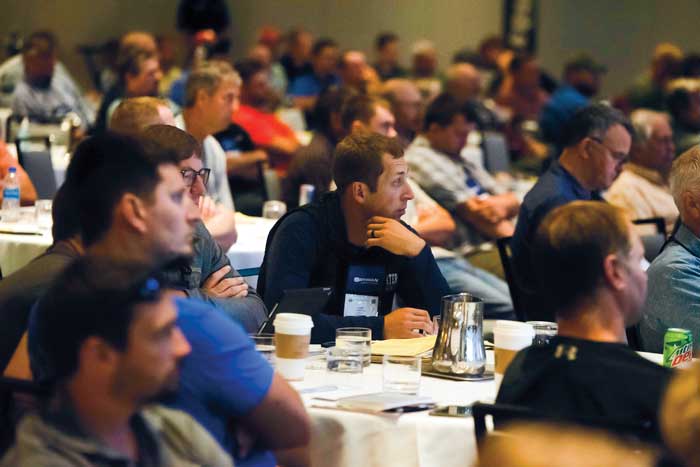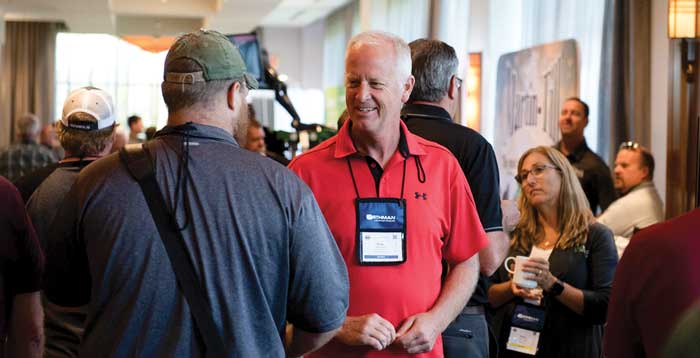From practical advice on alleviating compaction to conflicting views on soil health to a former NASA engineer’s new yield-boosting technology, the 2022 National Strip-Tillage Conference sent attendees home with many new ideas to try on their operations — and a lot to talk about at the coffee shop.
More than 350 farmers, agronomists and industry experts attended the 9th Annual Strip-Tillage Conference in Iowa City, Iowa, at the end of July. The 2-day event featured dozens of general sessions, classrooms and roundtables to facilitate discussions about practical, proven strategies for successful strip-tilling.
Strip-Till Discoveries
Mike Petersen, the independent consultant and former NRCS soil scientist based in Greeley, Colo., kicked off the conference with a look into the past of strip-till. Petersen has been researching successful strip-till practices for more than 35 years, and he says understanding the past is key to moving the practice into the future.
Western Corn Belt strip-tillers pushed corn dryland yields from 25 bushels in 1987 to 100-110 bushels today — even as drought conditions worsened and water supplies tightened. Key to the increase was adopting strip-till and the better water holding abilities and nutrient placement that comes with it.
“Roots don’t seek nutrients,” Petersen says. “They’ve got to run into them. Where you place nutrients means a whole lot, and strip-till is the system to do it.”
Even in the last decade, Petersen says university researchers used strip-till to establish that if fertility was off by 8 inches, it costs a farmer 27-31 bushels per acre. If it was off by 4 inches, the loss is 3-10 bushels per acre. Farmers using a 30-inch row system commonly sidedressed in the middle of the row, meaning the nutrients were placed 15 inches away from the plant. Petersen says it would take 10-16 days for the plant to reach those nutrients, and if the plant was fed at knee-high, the farmer missed the window of opportunity.
“Today, if we put nutrients anywhere from 6-7 inches away from the plant, the plant has access to it in 3 days,” Petersen says. “It really makes a world of difference on how we feed the plant, and using a strip-till system makes it happen.”
Feed the Plant
Indiana strip-tiller Chris Perkins has the same philosophy about feeding the plant through banded fertilizer placement. Perkins owns Banded Ag, an ag research, consulting and custom application business. He has more than 10,000 acres under contract for Banded Ag’s custom strip-till banded application in Indiana and Kentucky.
Using his systems-approach banding program, Perkins bumped corn yields on his own family farm by 50-60 bushels per acre. The program focuses on hybrid selection, adequate and efficient application of nutrients for the crop, optimized planting populations, and protecting the health of the corn plants through the season.

IN SESSION. Attendees at the 2022 National Strip-Tillage Conference take notes as University of Minnesota extension educator Jodi DeJong-Hughes dispels myths about compaction. More than 350 farmers, agronomists and industry experts attended the conference in Iowa City, Iowa.
In his years of trials, Perkins found a difference in how hybrids responded to banded fertilizer. The ideal hybrid has a smaller root structure with more fine and fibrous root hairs because large roots can cost yield. Perkins boils down yield to a mathematical equation: (plants per acre) x (kernels per plant) x (weight per kernel) = Corn Yield.
“If I’m paid off of yield, which is kernels, the quick way to get more kernels is to simply plant more plants,” Perkins says.
The ideal corn population in a 30-inch row is roughly 38,000, according to Perkins. This is the sweet spot where strip-tillers will get a positive return on investment for the additional seed expense. Strip-tillers at the conference asked Perkins a lot of questions about his system, and it was one of the liveliest discussions of the event.
Reduce Axle Loads
Jodi DeJong-Hughes, a University of Minnesota extension educator who focuses on the physical side of soil, dispelled a number of myths about compaction during her lecture at the conference.
To start, the freeze-thaw cycle won’t take care of compaction, especially if it’s deep. Multiple freeze-thaw cycles will only affect the top 2-5 inches in states that do get below freezing, DeJong-Hughes says. Under certain conditions, heavy equipment can push compaction down 4 feet deep.
“How many freeze-thaw cycles do you get at 4 feet?” DeJong-Hughes asks. “In Alabama, probably none. In Minnesota, we might get one — but not every year.”
If soil is wet, it will compact. DeJong-Hughes says about 3 days after a good rain, right when farmers want to get back out into the field, is prime for compacting soil, and about 80% of compaction happens on the first pass.
She recommends axle loads of 5-10 tons to reduce compaction. For equipment heavier than that, DeJong-Hughes says it’s critical to control traffic. Grain carts, usually the heaviest equipment on the field, should follow the old combine tracks back to the headlands, rather than drive across the field at a diagonal. This will minimize the amount of traffic out on the field.
Tackling Today’s Issues
Brand new at the conference this year was the “Beer & Bull Session,” a panel discussion that treated conference goers to an end-of-the-day beverage and the opportunity to ask five expert strip-tillers about their operations.
High fertilizer prices were on everyone’s mind, and an audience member asked the panelists how they were combating the costs in 2022 and 2023.

STRIP-TILL INNOVATOR. Brian Ryberg, the 2022 Strip-Till Innovator from Buffalo Lake, Minn., talks with another farmer at the 2022 National Strip-Tillage Conference. Conference attendees say hallway networking is a highlight of the event.
Lake Mills, Iowa, strip-tiller Ben Pederson, says he’s been putting all the nutrients in the strip for quite some time, so he’s planning on doing more of the same — banding nutrients, making his system more efficient and not using nutrients where they aren’t absolutely needed.
“Off the cuff, I’m thinking maybe cut back 25%,” Pederson says. “We have been pretty aggressive, especially in potassium. We’ll see where the numbers come out.”
Perkins says he won’t be cutting back on nutrients. He made some cuts to his program in previous years, and after looking at old data, he hasn’t seen strong evidence for pulling the rates back without cutting the crop too short. He’s currently running about 170 pounds of nitrogen (N) total, putting him at the 0.56-0.63 range for the N to bushel ratio.
“15-20 pounds in a bar can make quite an impact when banding, but when you look at it on a per-acre basis, 15-20 pounds on price doesn’t make that much of an impact,” Perkins says. “We’re continuing forward with the mix that we’ve been successful with.”
Steve Tesarik, a strip-tiller in Whitelaw, Wis., and his son decided to try using the nutrients built up in the soil profile and broadcasted no fertilizer this year. They cut back potassium (K) levels to 75% and banded all nutrients with the strip-till rig. They also have a neighbor with a municipal sludge application business, and that’s provided a free source of N and phosphorus (P).
“We got probably anywhere from 160-200 units of N out of that sludge, and it’s a high-P material with no K,” Tesarik says. “We have enough P for probably 15 years of growing corn.”
The 2022 conference also featured 14 classroom sessions and 18 roundtable discussions focused on strip-till trends like nutrient management amid high fertilizer prices, intercropping and companion cropping, strip-tilling into a perennial living mulch, alternative input strategies and weed control in strip-till systems.
“The value I got from this year’s conference was networking with other farmers going through the same struggles as us and collaborating on how to fix those challenges,” says Ohio strip-tiller Bradley Rine.







